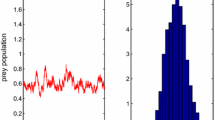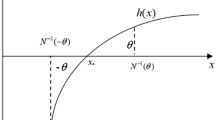Appendix A: Calculation of the Derivation of the Bound
Making use of Itô’s formula leads to
$$\begin{aligned} L(V_{5})= & {} \bigg (x+\displaystyle \frac{y}{k}+\frac{D+d_{1}}{2Dk}z\bigg )^{\theta }\bigg [x(r-ax)\\&-\,\frac{D+d_{1}}{2k}y-\frac{d_{2}(D+d_{1})}{2Dk}z\bigg ]+\frac{\theta }{2} \bigg (x+\displaystyle \frac{y}{k}+\frac{D+d_{1}}{2Dk}z\bigg )^{\theta -1}\\&\times \,\bigg (\sigma _{1}^{2}x^{2}+\displaystyle \frac{\sigma _{2}^{2}}{k^{2}}y^{2}+\frac{(D+d_{1})^{2}}{4D^{2}k^{2}}\sigma _{3}^{2}z^{2}\bigg )\\\le & {} \bigg (x+\displaystyle \frac{y}{k}+\frac{D+d_{1}}{2Dk}z\bigg )^{\theta }\bigg [x(r-ax)-\frac{D+d_{1}}{2k}y-\frac{d_{2}(D+d_{1})}{2Dk}z\bigg ]\\&+\,\frac{\theta }{2}\bigg (x+ \displaystyle \frac{y}{k}+\frac{D+d_{1}}{2Dk}z\bigg )^{\theta +1}(\sigma _{1}^{2}\vee \sigma _{2}^{2}\vee \sigma _{3}^{2})\\\le & {} rx\bigg (x+\displaystyle \frac{y}{k}+\frac{D+d_{1}}{2Dk}z\bigg )^{\theta }-ax^{\theta +2}-\frac{d_{1}}{2k^{\theta +1}}y^{\theta +1}-\frac{d_{2}(D+d_{1})^{\theta +1}}{(2Dk)^{\theta +1}}z^{\theta +1}\\&+\,\frac{\theta }{2}\bigg (x+\displaystyle \frac{y}{k}+\frac{D+d_{1}}{2Dk}z\bigg )^{\theta +1}\times (\sigma _{1}^{2}\vee \sigma _{2}^{2}\vee \sigma _{3}^{2})\\= & {} -\displaystyle \frac{a}{2}x^{\theta +2}-\frac{d_{1}}{4k^{\theta +1}}y^{\theta +1}-\frac{d_{2}(D+d_{1})^{\theta +1}}{2^{\theta +2}(Dk)^{\theta +1}}z^{\theta +1}\\&-\,\frac{a}{2}x^{\theta +2}-\frac{d_{1}}{4k^{\theta +1}}y^{\theta +1}-\frac{d_{2}(D+d_{1})^{\theta +1}}{2^{\theta +2}(Dk)^{\theta +1}}z^{\theta +1}\\&+\,rx\bigg (x+\displaystyle \frac{y}{k}+\frac{D+d_{1}}{2Dk}z\bigg )^{\theta }+\frac{\theta }{2}\bigg (x+\displaystyle \frac{y}{k}+\frac{D+d_{1}}{2Dk}z\bigg )^{\theta +1}(\sigma _{1}^{2}\vee \sigma _{2}^{2}\vee \sigma _{3}^{2})\\\le & {} -\displaystyle \frac{a}{2}x^{\theta +2}-\frac{d_{1}}{4k^{\theta +1}}y^{\theta +1}-\frac{d_{2}(D+d_{1})^{\theta +1}}{2^{\theta +2}(Dk)^{\theta +1}}z^{\theta +1}\\&-\,\frac{a}{2}x^{\theta +2} -\frac{d_{1}}{4k^{\theta +1}}y^{\theta +1}-\frac{d_{2}(D+d_{1})^{\theta +1}}{2^{\theta +2}(Dk)^{\theta +1}}z^{\theta +1}\\&+\,rx\bigg (x+\displaystyle \frac{y}{k}+\frac{D+d_{1}}{2Dk}z\bigg )^{\theta }\\&+\,\frac{3^{\theta }\theta }{2}\bigg (x^{\theta +1}+\bigg (\displaystyle \frac{y}{k}\bigg )^{\theta +1}+\bigg (\frac{D +d_{1}}{2Dk}\bigg )^{\theta +1}z^{\theta +1}\bigg )(\sigma _{1}^{2}\vee \sigma _{2}^{2}\vee \sigma _{3}^{2})\nonumber \\ \end{aligned}$$
$$\begin{aligned}= & {} -\displaystyle \frac{a}{2}x^{\theta +2}-\frac{d_{1}}{4k^{\theta +1}}y^{\theta +1}-\frac{d_{2}(D+d_{1})^{\theta +1}}{2^{\theta +2}(Dk)^{\theta +1}}z^{\theta +1}\\&-\,\frac{a}{2}x^{\theta +2}+\frac{3^{\theta }\theta }{2}(\sigma _{1}^{2}\vee \sigma _{2}^{2}\vee \sigma _{3}^{2})x^{\theta +1}+rx\bigg (x+\displaystyle \frac{y}{k}+\frac{D+d_{1}}{2Dk}z\bigg )^{\theta }\\&-\,\displaystyle \frac{d_{1}}{8k^{\theta +1}}y^{\theta +1}-\frac{d_{2}(D+d_{1})^{\theta +1}}{2^{\theta +3}(Dk)^{\theta +1}}z^{\theta +1}-\bigg (\frac{d_{1}}{8k^{\theta +1}}-\frac{3^{\theta } \theta }{2k^{\theta +1}}(\sigma _{1}^{2}\vee \sigma _{2}^{2}\vee \sigma _{3}^{2})\bigg )y^{\theta +1}\\&-\,\bigg (\displaystyle \frac{d_{2}(D+d_{1})^{\theta +1}}{2^{\theta +3}(Dk)^{\theta +1}}-\frac{3^{\theta }\theta (D+d_{1})^{\theta +1}}{2^{\theta +2}(Dk)^{\theta +1}}(\sigma _{1}^{2}\vee \sigma _{2}^{2}\vee \sigma _{3}^{2})\bigg )z^{\theta +1}\\\le & {} -\displaystyle \frac{a}{2}x^{\theta +2}-\frac{d_{1}}{4k^{\theta +1}}y^{\theta +1}-\frac{d_{2}(D+d_{1})^{\theta +1}}{2^{\theta +2}(Dk)^{\theta +1}}z^{\theta +1}\\&-\,\frac{a}{2}x^{\theta +2}+ \frac{3^{\theta }\theta }{2}(\sigma _{1}^{2}\vee \sigma _{2}^{2}\vee \sigma _{3}^{2})x^{\theta +1}+rx\bigg (x+\displaystyle \frac{y}{k}+\frac{D+d_{1}}{2Dk}z\bigg )^{\theta }\\&-\,\displaystyle \frac{d_{1}}{8k^{\theta +1}}y^{\theta +1}-\frac{d_{2}(D+d_{1})^{\theta +1}}{2^{\theta +3}(Dk)^{\theta +1}}z^{\theta +1}\\= & {} -\displaystyle \frac{a}{2}x^{\theta +2}-\frac{d_{1}}{4k^{\theta +1}}y^{\theta +1}-\frac{d_{2}(D+d_{1})^{\theta +1}}{2^{\theta +2}(Dk)^{\theta +1}}z^{\theta +1}\\&-\,\frac{a}{2}x^{\theta +2}+ \frac{3^{\theta }\theta }{2}\sigma _{\max }x^{\theta +1}+rx\bigg (x+\displaystyle \frac{y}{k}+\frac{D+d_{1}}{2Dk}z\bigg )^{\theta }\\&-\,\displaystyle \frac{d_{1}}{8k^{\theta +1}}y^{\theta +1}-\frac{d_{2}(D+d_{1})^{\theta +1}}{2^{\theta +3}(Dk)^{\theta +1}}z^{\theta +1}\\\le & {} -\displaystyle \frac{a}{2}x^{\theta +2}-\frac{d_{1}}{4k^{\theta +1}}y^{\theta +1}-\frac{d_{2}(D+d_{1})^{\theta +1}}{2^{\theta +2}(Dk)^{\theta +1}}z^{\theta +1}+B, \end{aligned}$$
where
$$\begin{aligned}&\sigma _{\max }{:}{=}\,\sigma _{1}^{2}\vee \sigma _{2}^{2}\vee \sigma _{3}^{2}=\max \{\sigma _{1}^{2},\sigma _{2}^{2},\sigma _{3}^{2}\},\\&\quad B=\sup _{(x,y,z)\in \mathbb {R}_{+}^{3}}\bigg \{-\displaystyle \frac{a}{2}x^{\theta +2}-\frac{d_{1}}{8k^{\theta +1}}y^{\theta +1}-\frac{d_{2}(D+d_{1})^{\theta +1}}{2^{\theta +3}(Dk)^{\theta +1}} z^{\theta +1}\\&+\,\frac{3^{\theta }\theta }{2}\sigma _{\max }x^{\theta +1}+rx\bigg (x+\frac{y}{k}+\frac{D+d_{1}}{2Dk}z\bigg )^{\theta }\bigg \} \end{aligned}$$
and in the third inequality we have used the fact that \(|\sum _{i=1}^{k}v_{i}|^{p}\le k^{p-1}\sum _{i=1}^{k}|v_{i}|^{p}\) for \(\forall p\ge 1\).
Appendix B: Verification of the Condition \(A_{2}\) in Lemma 2.1
By system (1.2), we have
$$\begin{aligned} L(x)=x(r-ax)-\displaystyle \frac{bxz}{1+mx}\le x(r-ax)\le -\frac{r}{m}(1+mx)+\frac{r(a+mr)}{am},\qquad \end{aligned}$$
(B.1)
where the second inequality holds due to the fact that \(a(x-\frac{r}{a})^{2}\ge 0\). Moreover, we obtain
$$\begin{aligned} L(-\ln y)=-\displaystyle \frac{kbxz}{(1+mx)y}+D+d_{1}+\frac{\sigma _{2}^{2}}{2} \end{aligned}$$
(B.2)
and
$$\begin{aligned} L(-\ln z)=-\displaystyle \frac{Dy}{z}+d_{2}+\frac{\sigma _{3}^{2}}{2}. \end{aligned}$$
(B.3)
It follows from (B.1), (B.2) and (B.3) that
$$\begin{aligned} L(V_{1})\le & {} -\frac{kbxz}{(1+mx)y}-\frac{c_{1}r}{m}(1+mx)-\frac{c_{2}Dy}{z}+\bigg (D+d_{1}+\frac{\sigma _{2}^{2}}{2}\bigg )\nonumber \\&+\,\frac{c_{1}r(a+mr)}{am}+c_{2}\bigg (d_{2}+\frac{\sigma _{3}^{2}}{2}\bigg )\nonumber \\ {}\le & {} -3\root 3 \of {\displaystyle \frac{c_{1}c_{2}kbDr}{m}}\root 3 \of {x}+\bigg (D+d_{1}+\displaystyle \frac{\sigma _{2}^{2}}{2}\bigg )+\frac{c_{1}r(a+mr)}{am} \nonumber \\&+\,c_{2}\bigg (d_{2}+\frac{\sigma _{3}^{2}}{2}\bigg ), \end{aligned}$$
(B.4)
where in the second inequality we have used Lemma 4.1. Moreover, we get
$$\begin{aligned} L\bigg (\frac{x}{r}\bigg )=x\bigg (1-\frac{ax}{r}\bigg )-\frac{bxz}{r(1+mx)}\le x\bigg (1-\frac{ax}{r}\bigg ) \end{aligned}$$
and
$$\begin{aligned} L\bigg (-\frac{\ln x}{r}\bigg )=-\bigg (1-\frac{ax}{r}\bigg )+\frac{bz}{r(1+mx)}+\frac{\sigma _{1}^{2}}{2r}\le \frac{ax}{r}-1+\frac{b}{r}z+\frac{\sigma _{1}^{2}}{2r}. \end{aligned}$$
In view of Lemma 4.2, we have
$$\begin{aligned} L(V_{2})\le \bigg [\displaystyle \frac{2}{3}\frac{ax}{r}\bigg (1-\frac{ax}{r}\bigg )+\frac{ax}{r}\bigg ]-1+\frac{b}{r}z+\frac{\sigma _{1}^{2}}{2r}\le \root 3 \of {\frac{a}{r}}\root 3 \of {x}-1+ \frac{b}{r}z+\frac{\sigma _{1}^{2}}{2r}.\nonumber \\ \end{aligned}$$
(B.5)
Therefore, by (B.4) and (B.5), one can see that
$$\begin{aligned} L(V_{3})\le & {} -3\root 3 \of {\frac{c_{1}c_{2}kbDr}{m}}\root 3 \of {x}+\bigg (D+d_{1}+\displaystyle \frac{\sigma _{2}^{2}}{2}\bigg )\nonumber \\&+\,\frac{c_{1}r(a+mr)}{am}+c_{2}\bigg (d_{2}+\frac{ \sigma _{3}^{2}}{2}\bigg )+3\root 3 \of {\frac{c_{1}c_{2}kbDr}{m}}\root 3 \of {x}\nonumber \\&-\,3\root 3 \of {\frac{c_{1}c_{2}kbDr^{2}}{ma}}\bigg (1-\frac{\sigma _{1}^{2}}{2r}\bigg )+\frac{3b}{r}\root 3 \of {\frac{c_{1}c_{2}kbDr^{2}}{ma}}z\nonumber \\= & {} \bigg (D+d_{1}+\displaystyle \frac{\sigma _{2}^{2}}{2}\bigg )+\frac{c_{1}r(a+mr)}{am}+c_{2}\bigg (d_{2}+\frac{\sigma _{3}^{2}}{2}\bigg )\nonumber \\&-\,3\root 3 \of {\frac{c_{1}c_{2}kbDr^{2}}{ma}}\bigg (1-\frac{\sigma _{1}^{2}}{2r}\bigg ) +\frac{3b}{r}\root 3 \of {\frac{c_{1}c_{2}kbDr^{2}}{ma}}z. \end{aligned}$$
(B.6)
Taking \(c_{1}=\frac{kbDam\left( 1-\frac{\sigma _{1}^{2}}{2r}\right) ^{3}}{(a+mr)^{2}\left( d_{2}+\frac{\sigma _{3}^{2}}{2}\right) }\), \(c_{2}=\frac{kbDr\left( 1-\frac{\sigma _{1}^{2}}{2r}\right) ^{3}}{(a+mr)\left( d_{2}+\frac{\sigma _{3}^{2}}{2}\right) ^{2}}\), according to (B.6), we obtain
$$\begin{aligned} L(V_{3})\le & {} \bigg (D+d_{1}+\frac{\sigma _{2}^{2}}{2}\bigg )+\frac{2kbDr}{(a+mr)\left( d_{2}+\frac{\sigma _{3}^{2}}{2}\right) }\bigg (1-\frac{\sigma _{1}^{2}}{2r}\bigg )^{3}\nonumber \\&-\,\frac{3kbDr}{(a+mr)\left( d_{2}+\frac{\sigma _{3}^{2}}{2}\right) }\bigg (1-\frac{\sigma _{1}^{2}}{2r}\bigg )^{3}+\frac{3b}{r}\root 3 \of {\frac{c_{1}c_{2}kbDr^{2}}{ma}}z\nonumber \\= & {} -\bigg (D+d_{1}+\frac{\sigma _{2}^{2}}{2}\bigg )\left( R_{0}^{S}-1\right) +\frac{3b}{r}\root 3 \of {\frac{c_{1}c_{2}kbDr^{2}}{ma}}z, \end{aligned}$$
(B.7)
where
$$\begin{aligned} R_{0}^{S}=\frac{kbDr}{(a+mr)\left( D+d_{1}+\frac{\sigma _{2}^{2}}{2}\right) \left( d_{2}+\frac{\sigma _{3}^{2}}{2}\right) }\bigg (1-\frac{\sigma _{1}^{2}}{2r}\bigg )^{3}. \end{aligned}$$
Noting that
$$\begin{aligned}&L\bigg (\frac{3b}{d_{2}r}\root 3 \of {\frac{c_{1}c_{2}kbDr^{2}}{ma}}z+\frac{3bD}{d_{2}r(D+d_{1})}\root 3 \of {\frac{c_{1}c_{2}kbDr^{2}}{ma}}y\bigg )\nonumber \\&=\frac{3k^{2}b ^{3}D^{2}\left( 1-\frac{\sigma _{1}^{2}}{2r}\right) ^{2}}{d_{2}(D+d_{1})(a+mr)\left( d_{2}+\frac{\sigma _{3}^{2}}{2}\right) }\frac{xz}{1+mx}\nonumber \\&\quad +\,\frac{3bD}{d_{2}r}\root 3 \of {\frac{c_{1}c_{2}kbDr^{2}}{ma}}y-\frac{3bD}{ d_{2}r}\root 3 \of {\frac{c_{1}c_{2}kbDr^{2}}{ma}}y-\frac{3b}{r}\root 3 \of {\frac{c_{1}c_{2}kbDr^{2}}{ma}}z\nonumber \\&=\frac{3k^{2}b^{3}D^{2}\left( 1-\frac{\sigma _{1}^{2}}{2r}\right) ^{2}}{d_{2}(D+d_{1 })(a+mr)\left( d_{2}+\frac{\sigma _{3}^{2}}{2}\right) }\frac{xz}{1+mx}-\frac{3b}{r}\root 3 \of {\frac{c_{1}c_{2}kbDr^{2}}{ma}}z, \end{aligned}$$
(B.8)
then by (B.7) and (B.8), we obtain
$$\begin{aligned} L(V_{4})\le & {} -\bigg (D+d_{1}+\frac{\sigma _{2}^{2}}{2}\bigg )\left( R_{0}^{S}-1\right) +\frac{3k^{2}b^{3}D^{2}\left( 1-\frac{\sigma _{1}^{2}}{2r}\right) ^{2}}{d_{2}(D+d_{1})(a+mr)\left( d_{2}+\frac{\sigma _{3}^{2}}{2}\right) }\frac{xz}{1+mx}\nonumber \\ {}= & {} -\lambda +\frac{3k^{2}b^{3}D^{2}\left( 1-\frac{\sigma _{1}^{2}}{2r}\right) ^{2}}{d_{2}(D+d_{1})(a+mr)\left( d_{2}+\frac{\sigma _{3}^{2}}{2}\right) }\frac{xz}{1+mx}, \end{aligned}$$
(B.9)
where
$$\begin{aligned} \lambda :=\bigg (D+d_{1}+\displaystyle \frac{\sigma _{2}^{2}}{2}\bigg )\left( R_{0}^{S}-1\right) >0. \end{aligned}$$
Furthermore, we have (see Appendix A for a detailed derivation)
$$\begin{aligned} L(V_{5})\le -\displaystyle \frac{a}{2}x^{\theta +2}-\frac{d_{1}}{4k^{\theta +1}}y^{\theta +1}-\frac{d_{2}(D+d_{1})^{\theta +1}}{2^{\theta +2}(Dk)^{\theta +1}}z^{\theta +1}+B, \end{aligned}$$
(B.10)
where B is a positive constant, depending only on the system parameters, whose precise definition can be found in Appendix A.
It follows from (B.2), (B.9) and (B.10) that
$$\begin{aligned} L(V)\le & {} -M\lambda +\displaystyle \frac{3Mk^{2}b^{3}D^{2}\left( 1-\frac{\sigma _{1}^{2}}{2r}\right) ^{2}}{d_{2}(D+d_{1})(a+mr)\left( d_{2}+\frac{\sigma _{3}^{2}}{2}\right) }\frac{xz}{1+mx}-\frac{kbxz}{y(1+mx)} \\&-\,\frac{a}{2}x^{\theta +2}-\frac{d_{1}}{4k^{\theta +1}}y^{\theta +1}-\frac{d_{2}(D+d_{1})^{\theta +1}}{2^{\theta +2}(Dk)^{\theta +1}}z^{\theta +1}\\&+\,B+D+d_{1}+\displaystyle \frac{\sigma _{2}^{2}}{2}\\= & {} -M\lambda +\displaystyle \frac{3Mk^{2}b^{3}D^{2}\left( 1-\frac{\sigma _{1}^{2}}{2r}\right) ^{2}}{d_{2}(D+d_{1})(a+mr)\left( d_{2}+\frac{\sigma _{3}^{2}}{2}\right) }\frac{xz}{1+mx}\\&-\,\frac{kbxz}{y(1+mx)}-\frac{a}{4}x^{\theta +2}-\frac{d_{1}}{4k^{\theta +1}}y^{\theta +1}-\frac{d_{2}(D+d_{1})^{\theta +1}}{2^{\theta +3}(Dk)^{\theta +1}}z^{\theta +1}\\&-\,\displaystyle \frac{a}{4}x^{\theta +2}-\frac{d_{2}(D+d_{1})^{\theta +1}}{2^{\theta +3}(Dk)^{\theta +1}}z^{\theta +1}+B+D+d_{1}+\displaystyle \frac{\sigma _{2}^{2}}{2}. \end{aligned}$$
In order to validate the condition \(A_{2}\) in Lemma 2.1 holds, we only need to construct a bounded open set U. Define a bounded open set U as
$$\begin{aligned} U=\bigg \{(x,y,z)\in \mathbb {R}_{+}^{3}:\epsilon<x<\frac{1}{\epsilon },\epsilon ^{3}<y<\frac{1}{\epsilon ^{3}},\epsilon<z<\frac{1}{\epsilon }\bigg \}, \end{aligned}$$
where \(0<\epsilon <1\) is a sufficiently small number. In the set \(\mathbb {R}_{+}^{3}\setminus U\), we can choose \(\epsilon \) sufficiently small such that the following conditions hold
$$\begin{aligned}&\frac{3Mk^{2}b^{3}D^{2}\left( 1-\frac{\sigma _{1}^{2}}{2r}\right) ^{2}\theta \epsilon }{d_{2}(D+d_{1})(a+mr)\left( d_{2}+\frac{\sigma _{3}^{2}}{2}\right) (\theta +1)(1+m\epsilon )}\le 1, \end{aligned}$$
(B.11)
$$\begin{aligned}&\frac{3Mk^{2}b^{3}D^{2}\left( 1-\frac{\sigma _{1}^{2}}{2r}\right) ^{2}\epsilon }{d_{2}(D+d_{1})(a+mr)\left( d_{2}+\frac{\sigma _{3}^{2}}{2}\right) (\theta +1)(1+m\epsilon )}\le \frac{d_{2}(D+d_{1})^{\theta +1}}{2^{\theta +3}(Dk)^{\theta +1}},\qquad \quad \end{aligned}$$
(B.12)
$$\begin{aligned}&0<\epsilon \le \displaystyle \frac{d_{2}(D+d_{1})(a+mr)\left( d_{2}+\frac{\sigma _{3}^{2}}{2}\right) (\theta +2)}{3Mk^{2}b^{3}D^{2}\left( 1-\frac{\sigma _{1}^{2}}{2r}\right) ^{2}(\theta +1)}, \end{aligned}$$
(B.13)
$$\begin{aligned}&0<\epsilon \le \displaystyle \frac{ad_{2}(D+d_{1})(a+mr)\left( d_{2}+\frac{\sigma _{3}^{2}}{2}\right) (\theta +2)}{12Mk^{2}b^{3}D^{2}\left( 1-\frac{\sigma _{1}^{2}}{2r}\right) ^{2}}, \end{aligned}$$
(B.14)
$$\begin{aligned}&-\displaystyle \frac{kb}{\epsilon (1+m\epsilon )}+C\le -1, \end{aligned}$$
(B.15)
$$\begin{aligned}&-\displaystyle \frac{a}{4\epsilon ^{\theta +2}}+C\le -1, \end{aligned}$$
(B.16)
$$\begin{aligned}&-\displaystyle \frac{d_{2}(D+d_{1})^{\theta +1}}{2^{\theta +3}(Dk\epsilon )^{\theta +1}}+C\le -1, \end{aligned}$$
(B.17)
$$\begin{aligned}&-\displaystyle \frac{d_{1}}{4(k\epsilon ^{3})^{\theta +1}}+C\le -1, \end{aligned}$$
(B.18)
where C is a positive constant which will be given explicitly in expression (B.22). For convenience, we can divide \(U^{c}=\mathbb {R}_{+}^{3}\setminus U\) into six domains,
$$\begin{aligned} U_{1}= & {} \{(x,y,z)\in \mathbb {R}_{+}^{3}:0<x\le \epsilon \},~U_{2}=\{(x,y,z)\in \mathbb {R}_{+}^{3}:0<z\le \epsilon \},\\ U_{3}= & {} \{(x,y,z)\in \mathbb {R}_{+}^{3}:0<y\le \epsilon ^{3},x>\epsilon , z>\epsilon \},~U_{4}=\bigg \{(x,y,z)\in \mathbb {R}_{+}^{3}:x\ge \frac{1}{\epsilon }\bigg \},\\ U_{5}= & {} \bigg \{(x,y,z)\in \mathbb {R}_{+}^{3}:z\ge \frac{1}{\epsilon }\bigg \},~U_{6}=\bigg \{(x,y,z)\in \mathbb {R}_{+}^{3}:y\ge \frac{1}{\epsilon ^{3}}\bigg \}. \end{aligned}$$
Clearly, \(U^{c}=U_{1}\cup U_{2}\cup U_{3}\cup U_{4}\cup U_{5}\cup U_{6}\). Next, we prove that \(L(V(x,y,z))\le -1\) for any \((x,y,z)\in U^{c}\), which is equivalent to proving it on the above six domains, respectively.
Case 1 For any \((x,y,z)\in U_{1}\), since \(\frac{xz}{1+mx}\le \frac{\epsilon }{1+m\epsilon }z\le \frac{\epsilon }{1+m\epsilon }\frac{\theta +z^{\theta +1}}{\theta +1}=\frac{\theta \epsilon }{(\theta +1)(1+m\epsilon )}+\frac{\epsilon }{( \theta +1)(1+m\epsilon )}z^{\theta +1}\), we have
$$\begin{aligned} L(V)\le & {} -M\lambda +\displaystyle \frac{3Mk^{2}b^{3}D^{2}\left( 1-\frac{\sigma _{1}^{2}}{2r}\right) ^{2}\theta \epsilon }{d_{2}(D+d_{1})(a+mr)\left( d_{2}+\frac{\sigma _{3}^{2}}{2}\right) (\theta +1) (1+m\epsilon )}\nonumber \\&+\,\bigg (\frac{3Mk^{2}b^{3}D^{2}\left( 1-\frac{\sigma _{1}^{2}}{2r}\right) ^{2}\epsilon }{d_{2}(D+d_{1})(a+mr)\left( d_{2}+\frac{\sigma _{3}^{2}}{2}\right) (\theta +1)(1+m\epsilon )}\nonumber \\&-\,\frac{d_{2}(D+d_{1})^{\theta +1}}{2^{\theta +3}(Dk)^{\theta +1}}\bigg )z^{\theta +1}+B+D+d_{1}\nonumber \\&+\,\displaystyle \frac{\sigma _{2}^{2}}{2} \le -2+1+0=-1, \end{aligned}$$
(B.19)
which follows from (4.2), (B.11) and (B.12). Thus
$$\begin{aligned} L(V)\le -1~\text {on}~U_{1}. \end{aligned}$$
Case 2 For any \((x,y,z)\in U_{2}\), since \(\frac{xz}{1+mx}\le xz\le \epsilon x\le \epsilon \frac{\theta +1+x^{\theta +2}}{\theta +2}=\frac{(\theta +1)\epsilon }{\theta +2}+\frac{\epsilon }{\theta +2}x^{\theta +2}\), we obtain
$$\begin{aligned} L(V)\le & {} -M\lambda +\displaystyle \frac{3Mk^{2}b^{3}D^{2}\left( 1-\frac{\sigma _{1}^{2}}{2r}\right) ^{2}(\theta +1)\epsilon }{d_{2}(D+d_{1})(a+mr)\left( d_{2}+\frac{\sigma _{3}^{2}}{2}\right) (\theta +2)}\nonumber \\&+\,\bigg (\frac{3Mk^{2}b^{3}D^{2}\left( 1-\frac{\sigma _{1}^{2}}{2r}\right) ^{2}\epsilon }{d_{2}(D+d_{1})(a+mr)\left( d_{2}+\frac{\sigma _{3}^{2}}{2}\right) (\theta +2)}-\frac{a}{4}\bigg )x^{\theta +1}\nonumber \\&+B+D+d_{1}+\displaystyle \frac{\sigma _{2}^{2}}{2}\nonumber \\\le & {} -2+1+0=-1, \end{aligned}$$
(B.20)
which follows from (4.2), (B.13) and (B.14). Hence,
$$\begin{aligned} L(V)\le -1,~\forall (x,y,z)\in U_{2}. \end{aligned}$$
Case 3 For any \((x,y,z)\in U_{3}\), one can get that
$$\begin{aligned} L(V)\le & {} -\displaystyle \frac{kbxz}{y(1+mx)}-\frac{a}{4}x^{\theta +2}-\frac{d_{1}}{4k^{\theta +1}}y^{\theta +1}\nonumber \\&-\frac{d_{2}(D+d_{1})^{\theta +1}}{2^{\theta +3}(Dk)^{\theta + 1}}z^{\theta +1}-\frac{a}{4}x^{\theta +2}-\frac{d_{2}(D+d_{1})^{\theta +1}}{2^{\theta +3}(Dk)^{\theta +1}}z^{\theta +1}\nonumber \\&+\frac{3Mk^{2}b^{3}D^{2}\left( 1-\frac{\sigma _{1}^{2}}{2r}\right) ^{2} }{d_{2}(D+d_{1})(a+mr)\left( d_{2}+\frac{\sigma _{3}^{2}}{2}\right) }\frac{xz}{1+mx}+B+D+d_{1}+\frac{\sigma _{2}^{2}}{2}\nonumber \\ {}\le & {} -\frac{kbxz}{y(1+mx)}-\frac{a}{4}x^{\theta +2}-\frac{d_{1}}{4k ^{\theta +1}}y^{\theta +1}-\frac{d_{2}(D+d_{1})^{\theta +1}}{2^{\theta +3}(Dk)^{\theta +1}}z^{\theta +1}+C\nonumber \\ {}\le & {} -\frac{kbxz}{y(1+mx)}+C\nonumber \\ {}< & {} -\frac{kb\epsilon ^{2}}{\epsilon ^{3}(1+m\epsilon )}+C\nonumber \\ {}= & {} -\frac{kb}{\epsilon (1+m\epsilon )}+C\nonumber \\\le & {} -1, \end{aligned}$$
(B.21)
which follows from (B.15) and
$$\begin{aligned} C= & {} \sup _{(x,y,z)\in \mathbb {R}_{+}^{3}}\bigg \{-\displaystyle \frac{a}{4}x^{\theta +2}-\frac{d_{2}(D+d_{1})^{\theta +1}}{2^{\theta +3}(Dk)^{\theta +1}}z^{\theta +1}\nonumber \\&+\frac{3Mk^{2}b^{3}D^{2}\left( 1 -\frac{\sigma _{1}^{2}}{2r}\right) ^{2}}{d_{2}(D+d_{1})(a+mr)\left( d_{2}+\frac{\sigma _{3}^{2}}{2}\right) }\frac{xz}{1+mx}+B+D+d_{1}+\displaystyle \frac{\sigma _{2}^{2}}{2}\bigg \}.\nonumber \\ \end{aligned}$$
(B.22)
Therefore,
$$\begin{aligned} L(V)\le -1~\text {on}~U_{3}. \end{aligned}$$
Case 4 For any \((x,y,z)\in U_{4}\), one can see that
$$\begin{aligned} L(V)\le & {} -\displaystyle \frac{kbxz}{y(1+mx)}-\frac{a}{4}x^{\theta +2}-\frac{d_{1}}{4k^{\theta +1}}y^{\theta +1}-\frac{d_{2}(D+d_{1})^{\theta +1}}{2^{\theta +3}(Dk)^{\theta + 1}}z^{\theta +1}\nonumber \\&-\,\frac{a}{4}x^{\theta +2}-\frac{d_{2}(D+d_{1})^{\theta +1}}{2^{\theta +3}(Dk)^{\theta +1}}z^{\theta +1}\nonumber \\&+\,\frac{3Mk^{2}b^{3}D^{2}\left( 1-\frac{\sigma _{1}^{2}}{2r}\right) ^{2} }{d_{2}(D+d_{1})(a+mr)\left( d_{2}+\frac{\sigma _{3}^{2}}{2}\right) }\frac{xz}{1+mx}+B+D+d_{1}+\frac{\sigma _{2}^{2}}{2}\nonumber \\\le & {} -\frac{kbxz}{y(1+mx)}-\frac{a}{4}x^{\theta +2}-\frac{d_{1}}{4k ^{\theta +1}}y^{\theta +1}-\frac{d_{2}(D+d_{1})^{\theta +1}}{2^{\theta +3}(Dk)^{\theta +1}}z^{\theta +1}+C\nonumber \\ {}\le & {} -\frac{a}{4}x^{\theta +2}+C\nonumber \\< & {} -\frac{a}{4\epsilon ^{\theta +2}}+C\nonumber \\\le & {} -1, \end{aligned}$$
(B.23)
which follows from (B.16). So
$$\begin{aligned} L(V)\le -1,~\forall (x,y,z)\in U_{4}. \end{aligned}$$
Case 5 When \((x,y,z)\in U_{5}\), one can obtain that
$$\begin{aligned} L(V)\le & {} -\,\displaystyle \frac{kbxz}{y(1+mx)}-\frac{a}{4}x^{\theta +2}-\frac{d_{1}}{4k^{\theta +1}}y^{\theta +1}\nonumber \\&-\,\frac{d_{2}(D+d_{1})^{\theta +1}}{2^{\theta +3}(Dk)^{\theta + 1}}z^{\theta +1}-\frac{a}{4}x^{\theta +2}-\frac{d_{2}(D+d_{1})^{\theta +1}}{2^{\theta +3}(Dk)^{\theta +1}}z^{\theta +1}\nonumber \\&+\frac{3Mk^{2}b^{3}D^{2}\left( 1-\frac{\sigma _{1}^{2}}{2r}\right) ^{2} }{d_{2}(D+d_{1})(a+mr)\left( d_{2}+\frac{\sigma _{3}^{2}}{2}\right) }\frac{xz}{1+mx}+B+D+d_{1}+\frac{\sigma _{2}^{2}}{2}\nonumber \\ {}\le & {} -\frac{kbxz}{y(1+mx)}-\frac{a}{4}x^{\theta +2}-\frac{d_{1}}{4k ^{\theta +1}}y^{\theta +1}-\frac{d_{2}(D+d_{1})^{\theta +1}}{2^{\theta +3}(Dk)^{\theta +1}}z^{\theta +1}+C\nonumber \\\le & {} -\frac{d_{2}(D+d_{1})^{\theta +1}}{2^{\theta +3}(Dk)^{\theta +1}}z^{ \theta +1}+C\nonumber \\< & {} -\,\frac{d_{2}(D+d_{1})^{\theta +1}}{2^{\theta +3}(Dk\epsilon )^{\theta +1}}+C\le -1, \end{aligned}$$
(B.24)
which follows from (B.17). Consequently
$$\begin{aligned} L(V)\le -1~\text {on}~U_{5}. \end{aligned}$$
Case 6 If \((x,y,z)\in U_{6}\), one can see that
$$\begin{aligned} L(V)\le & {} -\,\displaystyle \frac{kbxz}{y(1+mx)}-\frac{a}{4}x^{\theta +2}-\frac{d_{1}}{4k^{\theta +1}}y^{\theta +1}\nonumber \\&-\,\frac{d_{2}(D+d_{1})^{\theta +1}}{2^{\theta +3}(Dk)^{\theta + 1}}z^{\theta +1}-\frac{a}{4}x^{\theta +2}-\frac{d_{2}(D+d_{1})^{\theta +1}}{2^{\theta +3}(Dk)^{\theta +1}}z^{\theta +1}\nonumber \\&+\frac{3Mk^{2}b^{3}D^{2}\left( 1-\frac{\sigma _{1}^{2}}{2r}\right) ^{2} }{d_{2}(D+d_{1})(a+mr)\left( d_{2}+\frac{\sigma _{3}^{2}}{2}\right) }\frac{xz}{1+mx}+B+D+d_{1}+\frac{\sigma _{2}^{2}}{2}\nonumber \\ {}\le & {} -\frac{kbxz}{y(1+mx)}-\frac{a}{4}x^{\theta +2}-\frac{d_{1}}{4k ^{\theta +1}}y^{\theta +1}-\frac{d_{2}(D+d_{1})^{\theta +1}}{2^{\theta +3}(Dk)^{\theta +1}}z^{\theta +1}+C\nonumber \\ {}\le & {} -\frac{d_{1}}{4k^{\theta +1}}y^{\theta +1}+C\nonumber \\ {}< & {} -\frac{d_{ 1}}{4(k\epsilon ^{3})^{\theta +1}}+C\nonumber \\\le & {} -1, \end{aligned}$$
(B.25)
which follows from (B.18). As a result
$$\begin{aligned} L(V)\le -1,~\forall (x,y,z)\in U_{6}. \end{aligned}$$
Obviously, from (B.19), (B.20), (B.21), (B.23), (B.24) and (B.25), we obtain that for a sufficiently small \(\epsilon \),
$$\begin{aligned} L(V(x,y,z))\le -1,~\forall (x,y,z)\in \mathbb {R}_{+}^{3}\setminus U. \end{aligned}$$
Hence, the condition \(A_{2}\) in Lemma 2.1 holds.
Appendix C: Detailed Calculation of the Last Integral of (5.16)
$$\begin{aligned}&J_{1}{:}{=}\displaystyle \int _{0}^{\infty }x\pi (x)\mathrm{d}x=Q\sigma _{1}^{-2}\int _{0}^{\infty }x^{\frac{2r}{\sigma _{1}^{2}}-1}\mathrm{e}^{-\frac{2a}{\sigma _{1}^{2}}x}\mathrm{d}x\\&\quad =Q\sigma _{1}^{-2}\int _{0}^{\infty }\bigg (\frac{\sigma _{1}^{2}}{2a}\bigg )^{\frac{2r}{\sigma _{1}^{2}}-1}t^{\frac{2r}{\sigma _{1}^{2}}-1}\mathrm{e}^{-t}\frac{\sigma _{1}^{2}}{2a}\mathrm{d}t=Q\sigma _{1}^{-2}\bigg (\frac{\sigma _{1}^{2}}{2a}\bigg )^{ \frac{2r}{\sigma _{1}^{2}}}\Gamma \bigg (\frac{2r}{\sigma _{1}^{2}}\bigg )\\&\quad =\displaystyle \frac{\sigma _{1}^{2}}{2a}\frac{\Gamma \left( \frac{2r}{\sigma _{1}^{2}}\right) }{\Gamma \left( \frac{2r}{\sigma _{1}^{2}}-1\right) }=\frac{\sigma _{1}^{2}}{2a}\bigg (\frac{2r}{\sigma _{1}^{2}}-1\bigg )= \frac{r-\frac{\sigma _{1}^{2}}{2}}{a} \end{aligned}$$
and
$$\begin{aligned}&J_{2}\,{:}{=}\displaystyle \int _{0}^{\infty }x^{2}\pi (x)\mathrm{d}x=Q\sigma _{1}^{-2}\int _{0}^{\infty }x^{\frac{2r}{\sigma _{1}^{2}}}\mathrm{e}^{-\frac{2a}{\sigma _{1}^{2}}x}\mathrm{d}x\\&\quad =Q\sigma _{1}^{-2}\int _{0}^{\infty } \bigg (\frac{\sigma _{1}^{2}}{2a}\bigg )^{\frac{2r}{\sigma _{1}^{2}}}t^{\frac{2r}{\sigma _{1}^{2}}}\mathrm{e}^{-t}\frac{\sigma _{1}^{2}}{2a}\mathrm{d}t=Q\sigma _{1}^{-2}\bigg (\frac{\sigma _{1}^{2}}{2a}\bigg )^{\frac{2r}{\sigma _{1}^{2}}+1}\Gamma \bigg (\frac{2r}{\sigma _{1}^{2}}+1\bigg )\\&\quad =\bigg (\displaystyle \frac{\sigma _{1}^{2}}{2a}\bigg )^{2}\frac{\Gamma \left( \frac{2r}{\sigma _{1}^{2}}+1\right) }{\Gamma \left( \frac{2r}{\sigma _{1}^{2}}-1\right) }\\&\quad =\bigg (\frac{\sigma _{1}^{2}}{2a}\bigg )^{2}\frac{2r}{\sigma _{1}^{2}}\bigg (\frac{2r}{\sigma _{1}^{2}}-1\bigg )=\frac{r\left( r-\frac{\sigma _{1}^{2}}{2}\right) }{a^{2}}. \end{aligned}$$
Hence, we have
$$\begin{aligned} \displaystyle \int _{0}^{\infty }\bigg (x-\frac{r}{a}\bigg )^{2}\pi (x)\mathrm{d}x= & {} \int _{0}^{\infty }\bigg (x^{2}-\frac{2r}{a}x+\frac{r^{2}}{a^{2}}\bigg )\pi (x)\mathrm{d}x=J_{2}-\frac{2r}{a}J_{1}+\frac{r^{2}}{a^{2}}\\= & {} \frac{r\left( r-\frac{\sigma _{1}^{2}}{2}\right) }{a^{2}}-\frac{2r}{a}\cdot \frac{r-\frac{\sigma _{1}^{2}}{2}}{a}+\frac{r^{2}}{a^{2}}=\frac{r\sigma _{1}^{2}}{2a^{2}}. \end{aligned}$$










